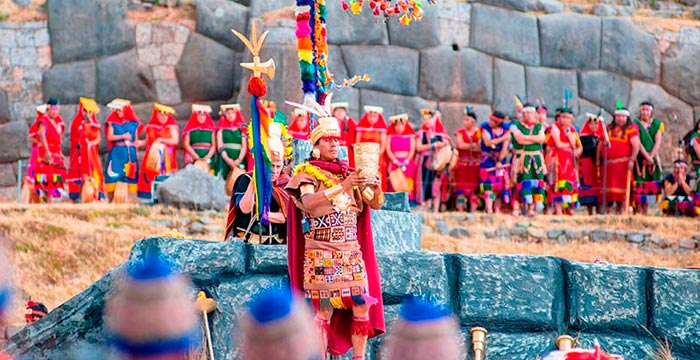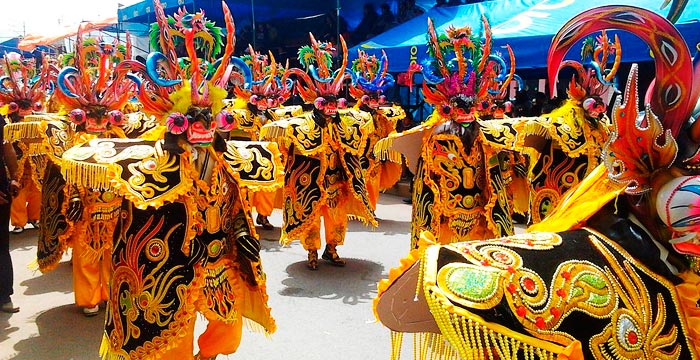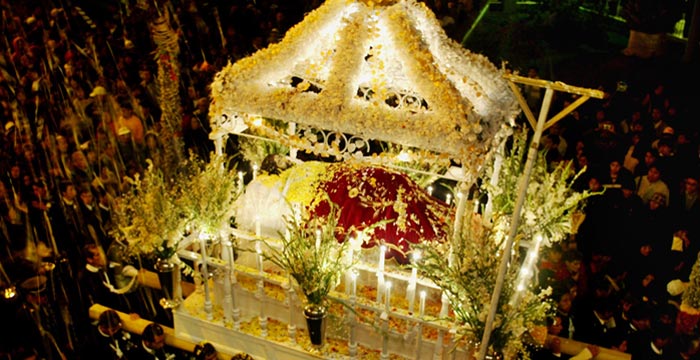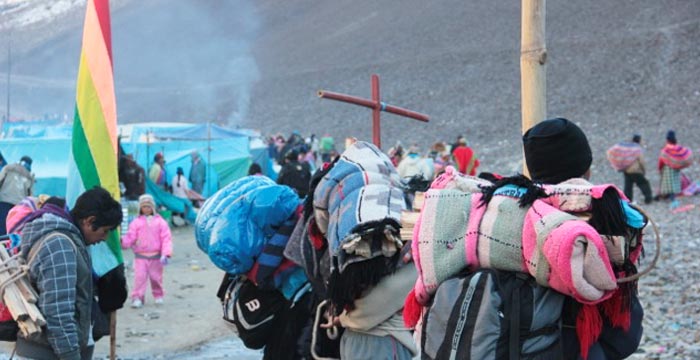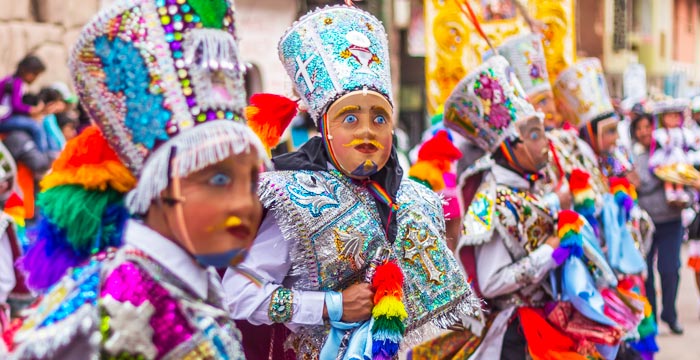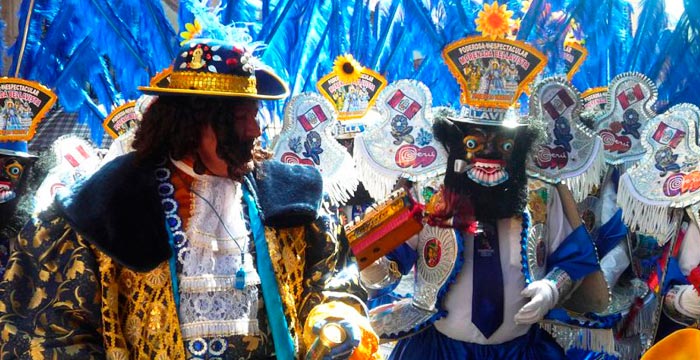Festival, Pilgrimages, & Processions in Peru
Whether you’re planning your custom Peru vacation for winter, spring, summer, or fall, there’s likely to be a major festival, pilgrimage, or procession unfolding somewhere in Peru. From Inti Raymi in Cusco in July to Carnival countrywide in February, experience the atmosphere of a true Peruvian celebration on your personalized tour of Peru.
Inti Raymi in Cusco, “Festival of the Sun”
Cusco’s biggest festival, Inti Raymi, originated with the Incas who used the ceremony to show their reverence for Inti, the sun god, when he was furthest away from Earth during the winter solstice. Back in the Inca heyday, participants would have sacrificed llamas. These days, the llamas are spared during the Inti Raymi reenactment, though little else has changed. The ceremony takes place amid the stone ruins of the Sacsayhuamán Archaeological Site and the multicolored costumes, woven masks and ceremonial rituals all combine to resemble the kind of scenes you would have witnessed during Incan times. Taking place on June 24, Inti Raymi is one of the most popular events in the country with crowds flocking from Cusco and beyond to witness the elaborate procession. Seats quickly fill as do rooms in Cusco during the event so let Kuoda know as far in advance as possible should you wish to attend. Peru Travel: Inti Raymi
Virgen del Carmen Festival in Cusco
Nothing much really happens in the small Andean town of Paucartambo, except for a few days in mid-July when the entire Sacred Valley, as well as thousands of tourists, trek here for the festival of the Virgen del Carmen. Lasting between three and four days, the festival is a round-the-clock event with music, dancing, drinking, eating and elaborate costumed reenactments. The festival celebrates the eponymous virgin, whose head – legend has it – appeared and chatted to a tradeswoman on a silver plate. In a typical-to-this-region blending of indigenous and Catholic beliefs, the virgin is said to be both an incarnation of the Virgin Mary and Pachamama, the Andean Mother Earth deity. This festival comes to a head on July 16, when the statue of the virgin – dressed in lavish garb and sprinkled with flower petals – is carried through the streets in a solemn processions said to ward off evil spirits. The Virgen del Carmen is a notoriously raucous and spirited event with an infectious energy – if you want to experience it for yourself, we can arrange for you to stay a while in this mountain town and witness the joyous celebrations.
Semana Santa, Easter & Holy Week in Peru
This cross-country Holy Week celebration is one of those experience-it-once-before-you-die activities and an event certainly worth considering as part of your customized tour of Peru. You might join the 10-day celebrations in Cusco, Huaraz or Tarma, but it’s the city of Ayacucho that takes things to a whole new level. Here, the town’s entire population put their lives on hold for the event as crowds flood in from far and near to witness the ceremonial processions, during which costumed worshippers carry statues of saints through the streets as well as music, dancing and drinking. It culminates in a gigantic party on Easter Saturday and fireworks to celebrate Jesus getting the upper-hand over death. Peru Travel: Semana Santa
The Pilgramige & Festival of Quyllurit'i
The annual mountain pilgrimage is a long-standing Andean tradition, taking place in the Sinkara Valley south of Cusco. Every year, thousands of mostly native Peruvian and Bolivian travelers arrive here to ascend the “apu” (sacred mountain) of Ausangate to pay homage to the Pleiades star group, which go AWOL from skies in early April before re-appearing again in June, signifying renewal and the upcoming harvest for the pilgrims. As they reach the glacier, some pilgrims harvest chunks of ice from it, believing them to have special medicinal and magical properties.
Between the thin, high-altitude air, the swirling music and symbolic dances performed by the costume-clad pilgrims, the Quyllurit’i pilgrimage can be a rather surreal and heady experience indeed – perfect for travelers to Peru who feel they’ve seen all there is to see! Things come to a climax at sunrise on the Monday when thousands of devotees kneel before the rising sun as the first rays of the day hit the Earth – a truly humbling display of religious devotion. Dates of the festival, which has been declared part of the Intangible Cultural Heritage of Humanity by UNESCO, vary according to the lunar cycle. Check with a Kuoda planning representative to find out when the festival is taking place this year.
Carnaval in Peru
Forty days before Easter Sunday, just before the Catholic period of Lent begins, parties get underway all across Peru. No doubt you’ve heard of Rio’s famous Carnaval celebrations, but things can and do get pretty wild here in Peru too, between the competitions and parties, costume parades and traditional water balloon fights, which usually turn into a battle of the sexes-style war between boys and girls! The water bomb fights can be unpredictable; walk down the wrong street in February and you may find yourself being pelted with balloons from unknown assailants up on the roofs – don’t worry, we’ll have towels on hand just in case!
The city of Cajamarca, in northeastern Peru, is an incredibly fun place to be during Carnaval season. During the celebrations here, look out for the yunsa tree, which can be identified by the various toys and ornaments hanging from its branches. Toward the end of the festivities, the yunsa tree is cut down and partygoers clamber to grab the best prizes from its branches. Cajamarca isn’t the only place to celebrate either; Huaraz, Iquitos and Puno also host happening Carnaval festivities. Planning a trip to Peru for February? Kuoda can help you experience some of that famous Carnaval cheer.
Virgen de la Candelaria Festival in Puno
Thanks to its proximity to the Lake Titicaca, this lakeside town sees a steady influx of visitors year-round, but the Virgen de la Candelaria Festival at the start of February is a whole other reason to call tourists to this town. This event, which runs for 18 days, is the third-largest Carnaval celebration in all of South America, with more than 50,000 dancers and 20,000 musicians lending their talent to the event.
February 2 – where marchers parade down the street wearing labor-intensive costumes loaded with sequins, tiny mirrors, ribbons, beads and fringe along with the Virgen de la Candelaria icon – is the festival’s zenith. If you are thinking about attending the festival, Kuoda can help build you a customized itinerary for your trip to Peru.

